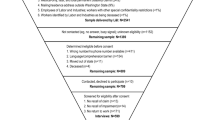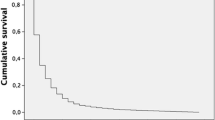Abstract
Background: Cumulative trauma disorders of the upper extremities (CTD) have become increasingly important in workers' compensation caseloads over the last two decades. Relative to occupational back pain, CTD have been much less studied. Methods: We analyzed post-injury employment patterns and return-to-work probabilities for a sample of Ontario workers with CTD, for up to five years after injury. Results for workers with CTD are compared to results for workers with back injuries or fractures. Results: Most workers with CTD return to work at least once, but a first return does not necessarily mark the end of work disability. Among workers absent at least once, 26% with CTD report a second injury-related absence, compared to 18% with back pain and 12% with fractures. After five years, focusing on first returns underestimates work-loss days associated with CTD by 32%. Conclusions: A substantial proportion of workers with CTD or work-related back pain experience injury-related absences after their first return to work. Focusing on the first return to work is misleading for both injury groups, but even more so for CTD, as they appear to be even more susceptible to multiple spells of work absence.




Similar content being viewed by others
Notes
We use the pre-injury wage and year of injury to determine the expected temporary disability benefit, taking account of benefit maxima and minima at the time the worker was injured, and then calculate an expected replacement rate. Permanent disability benefits are not included in the models because they are not conditioned on prior wage losses or current work status, so they are not expected to have the strong work disincentives associated with temporary disability benefits. In addition, although such benefits may have an income effect on work decisions, as a practical matter they are not available in our data.
The estimated coefficient of the replacement rate variable is nearly 50 percent greater, in absolute value, than the estimated effect in a similar model for back cases.
One possible explanation is that upper extremity disorders tend to occur in occupations/industries where it is more difficult to return to work after an injury than in the occupations/industries where back injuries and fractures are more likely to occur. We do not have occupation data on the Ontario data, but we re-estimated our models with a complete set of industry controls. Other industry variables were not significant and did not change the results for the replacement rate.
References
Cole DC, Van Eerd D, Bigelow P, Rivilis I. Integrative interventions for MSDs: nature, evidence, challenges and directions. (In process.) 2005.
Fabrizio AJ. Work-related upper extremity injuries: prevalence, cost and risk factors in military and civilian populations. Work 2002;18:115–21.
Feuerstein M, Miller VL, Burrell LM, Berger R. Occupational upper extremity disorders in the federal workforce. J Occup Environ Med 1998;40:546–55.
Hashemi L, Webster BS, Clancy EA, Volinn E. Length of disability and cost of workers’ compensation low back pain claims. J Occup Environ Med 1998;39:937–45.
Johnson WG, Baldwin ML, Butler RJ. Back pain and work disability: the need for a new paradigm. Ind Relat 1998;37:9–34.
Keogh JP, Nuwayhid I, Gordon JL, Gucer PW. The impact of occupational injury on injured worker and family: outcomes of upper extremity cumulative trauma disorders in Maryland workers. Am J Ind Med 2000;38:498–506.
Morse TF, Dillon C, Warren N, Levenstein C, Warren A. The economic and social consequence of work-related musculoskeletal disorders: The Connecticut Upper-Extremity Surveillance Project (CUSP). International Journal of Occupational and Environmental Health 1998;4:209–16.
Pransky G, Benjamin K, Hill-Fotouhi C, Fletcher KE, Himmelstein J. Occupational upper extremity conditions: a detailed analysis of work-related outcomes. J Occup Rehabil 2002;12:131–8.
Roquelaure Y, Cren S, Rousseau F, Touranchet A, Dano C, Fanello S, Penneau-Fontbonne D. Work status after workers' compensation claims for upper limb musculoskeletal disorders. Occup Environ Med 2004;61:79–81.
Sengupta I, Reno V, Burton JF Jr Workers’ compensation: benefits, coverage, and costs, 2003. Washington DC: National Academy of Social Insurance, 2005.
Silverstein B, Viikari-Juntura E, Kalat J. Work-related musculoskeletal disorders of the neck, back and upper extremity in Washington state: 1990–1998. Technical report no. 40-4A-2000. Olympia, WA: SHARP Program, 2000.
Silverstein B, Welp E, Nelson N, Kalat J. Claims incidence of work-related disorders of the upper extremities: Washington state, 1987 through 1995. Am J Public Health 1998;88:1827–33.
Yassi A, Sprout J, Tate R. Upper Limb Repetitive Strain Injuries in Manitoba. Am J Ind Med 1996;30:461–72.
Author information
Authors and Affiliations
Corresponding author
Additional information
Prepared for a Meeting on: Upper Extremity Disorders in the Workplace; Sponsored by: Office Ergonomics Research Committee, Annapolis, Maryland, September 23–24, 2005
Rights and permissions
About this article
Cite this article
Baldwin, M.L., Butler, R.J. Upper extremity disorders in the workplace: Costs and outcomes beyond the first return to work. J Occup Rehabil 16, 296–316 (2006). https://doi.org/10.1007/s10926-006-9043-2
Published:
Issue Date:
DOI: https://doi.org/10.1007/s10926-006-9043-2




